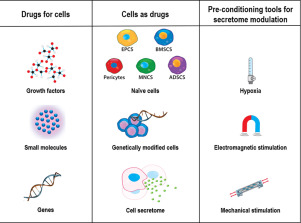当前位置:
X-MOL 学术
›
Adv. Drug Deliver. Rev.
›
论文详情
Our official English website, www.x-mol.net, welcomes your
feedback! (Note: you will need to create a separate account there.)
Local pharmacological induction of angiogenesis: Drugs for cells and cells as drugs.
Advanced Drug Delivery Reviews ( IF 15.2 ) Pub Date : 2019-06-19 , DOI: 10.1016/j.addr.2019.06.002 Diana Gaspar 1 , Rita Peixoto 1 , Andrea De Pieri 2 , Britta Striegl 3 , Dimitrios I Zeugolis 1 , Michael Raghunath 3
Advanced Drug Delivery Reviews ( IF 15.2 ) Pub Date : 2019-06-19 , DOI: 10.1016/j.addr.2019.06.002 Diana Gaspar 1 , Rita Peixoto 1 , Andrea De Pieri 2 , Britta Striegl 3 , Dimitrios I Zeugolis 1 , Michael Raghunath 3
Affiliation

|
The past decades have seen significant advances in pro-angiogenic strategies based on delivery of molecules and cells for conditions such as coronary artery disease, critical limb ischemia and stroke. Currently, three major strategies are evolving. Firstly, various pharmacological agents (growth factors, interleukins, small molecules, DNA/RNA) are locally applied at the ischemic region. Secondly, preparations of living cells with considerable bandwidth of tissue origin, differentiation state and preconditioning are delivered locally, rarely systemically. Thirdly, based on the notion, that cellular effects can be attributed mostly to factors secreted in situ, the cellular secretome (conditioned media, exosomes) has come into the spotlight. We review these three strategies to achieve (neo)angiogenesis in ischemic tissue with focus on the angiogenic mechanisms they tackle, such as transcription cascades, specific signalling steps and cellular gases. We also include cancer-therapy relevant lymphangiogenesis, and shall seek to explain why there are often conflicting data between in vitro and in vivo. The lion's share of data encompassing all three approaches comes from experimental animal work and we shall highlight common technical obstacles in the delivery of therapeutic molecules, cells, and secretome. This plethora of preclinical data contrasts with a dearth of clinical studies. A lack of adequate delivery vehicles and standardised assessment of clinical outcomes might play a role here, as well as regulatory, IP, and manufacturing constraints of candidate compounds; in addition, completed clinical trials have yet to reveal a successful and efficacious strategy. As the biology of angiogenesis is understood well enough for clinical purposes, it will be a matter of time to achieve success for well-stratified patients, and most probably with a combination of compounds.
中文翻译:

血管生成的局部药理诱导:细胞药物和细胞药物。
在过去的几十年中,基于针对诸如冠状动脉疾病,严重肢体缺血和中风的疾病的分子和细胞的输送,促血管生成策略取得了重大进展。当前,三个主要策略正在发展。首先,在局部缺血区域局部应用各种药物(生长因子,白介素,小分子,DNA / RNA)。其次,具有组织起源,分化状态和预处理能力的相当宽的活细胞制剂是局部递送的,很少系统地递送。第三,基于这一概念,细胞效应主要归因于原位分泌因子,因此细胞分泌组(条件培养基,外泌体)已成为人们关注的焦点。我们综述了这三种在缺血组织中实现(新)血管生成的策略,重点是它们处理的血管生成机制,例如转录级联,特定的信号传导步骤和细胞气体。我们还包括与癌症治疗有关的淋巴管生成,并应设法解释为什么在体外和体内之间经常存在冲突的数据。涵盖所有这三种方法的大部分数据来自实验动物工作,我们将重点介绍治疗分子,细胞和分泌组在递送方面的常见技术障碍。大量的临床前数据与缺乏临床研究形成了鲜明的对比。缺乏适当的载体和临床结果的标准化评估可能会在这里发挥作用,以及候选化合物的法规,知识产权和制造方面的限制;此外,完整的临床试验尚未揭示成功和有效的策略。由于对血管生成的生物学了解足以用于临床目的,因此对于分层良好的患者(最有可能使用化合物的组合)取得成功将是一个时间问题。
更新日期:2019-11-18
中文翻译:

血管生成的局部药理诱导:细胞药物和细胞药物。
在过去的几十年中,基于针对诸如冠状动脉疾病,严重肢体缺血和中风的疾病的分子和细胞的输送,促血管生成策略取得了重大进展。当前,三个主要策略正在发展。首先,在局部缺血区域局部应用各种药物(生长因子,白介素,小分子,DNA / RNA)。其次,具有组织起源,分化状态和预处理能力的相当宽的活细胞制剂是局部递送的,很少系统地递送。第三,基于这一概念,细胞效应主要归因于原位分泌因子,因此细胞分泌组(条件培养基,外泌体)已成为人们关注的焦点。我们综述了这三种在缺血组织中实现(新)血管生成的策略,重点是它们处理的血管生成机制,例如转录级联,特定的信号传导步骤和细胞气体。我们还包括与癌症治疗有关的淋巴管生成,并应设法解释为什么在体外和体内之间经常存在冲突的数据。涵盖所有这三种方法的大部分数据来自实验动物工作,我们将重点介绍治疗分子,细胞和分泌组在递送方面的常见技术障碍。大量的临床前数据与缺乏临床研究形成了鲜明的对比。缺乏适当的载体和临床结果的标准化评估可能会在这里发挥作用,以及候选化合物的法规,知识产权和制造方面的限制;此外,完整的临床试验尚未揭示成功和有效的策略。由于对血管生成的生物学了解足以用于临床目的,因此对于分层良好的患者(最有可能使用化合物的组合)取得成功将是一个时间问题。











































 京公网安备 11010802027423号
京公网安备 11010802027423号